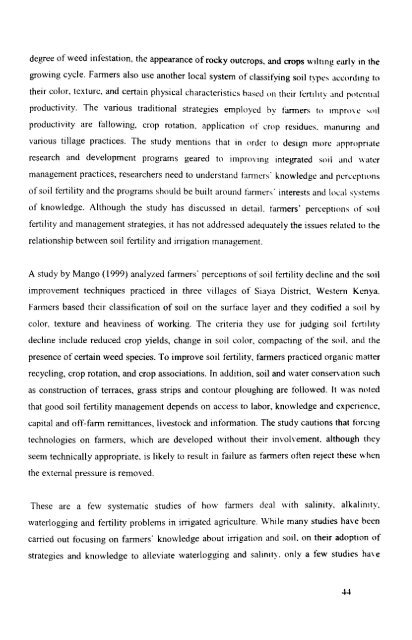Water Users Association and Irrigation Management - Institute for ...
Water Users Association and Irrigation Management - Institute for ...
Water Users Association and Irrigation Management - Institute for ...
You also want an ePaper? Increase the reach of your titles
YUMPU automatically turns print PDFs into web optimized ePapers that Google loves.
degree of weed infestation, the appearance of rocky outcrops, <strong>and</strong> crops wilting early in the<br />
growing cycle. Farmers also use another local system of classifying soil types according tll<br />
their color, texture, <strong>and</strong> certain physical characteristics hased on their fertilIty <strong>and</strong> p()t~'nllal<br />
productivity. The various traditional strategies employed hy farmers to IInpro\e "'II<br />
productivity are fallowing, crop rotation. application of crop residues. manunng <strong>and</strong><br />
various tillage practices. The study mentions that in order to desih'll more appropnate<br />
research <strong>and</strong> development programs geared to improVing integrated soli <strong>and</strong> water<br />
management practices, researchers need to underst<strong>and</strong> fanners' knowledge <strong>and</strong> perceptIOns<br />
of soil fertility <strong>and</strong> the programs should be built around htnners' interests <strong>and</strong> local systems<br />
of knowledge. Although the study has discussed in detail. farmers' perceptions of SOIl<br />
fertility <strong>and</strong> management strategies. it has not addressed adequately the issues related to the<br />
relationship between soil fertility <strong>and</strong> irrigation management.<br />
A study by Mango (1999) analyzed farmers' perceptions of soil fertility decline <strong>and</strong> the soil<br />
improvement techniques practiced in three villages of Siaya District, Western Kenya.<br />
Fanners based their classification of soil on the surface layer <strong>and</strong> they codified a soil hy<br />
color, texture <strong>and</strong> heaviness of working. The criteria they use <strong>for</strong> judging soil fertilIty<br />
decline include reduced crop yields, change in soil color, compacting of the soil. <strong>and</strong> the<br />
presence of certain weed species. To improve soil fertility, farmers practiced organic matter<br />
recycling, crop rotation, <strong>and</strong> crop associations. In addition, soil <strong>and</strong> water consenation such<br />
as construction of terraces, grass strips <strong>and</strong> contour ploughing are followed. It was noted<br />
that good soil fertility management depends on access to labor, knowledge <strong>and</strong> experience.<br />
capital <strong>and</strong> off-farm remittances, livestock <strong>and</strong> in<strong>for</strong>mation. The study cautions that <strong>for</strong>Cing<br />
technologies on farmers, which are developed without their involvement, although they<br />
seem technically appropriate. is likely to result in failure as farmers often reject these when<br />
the external pressure is removed.<br />
These are a few systematic studies of how farmers deal with salinity, alkalimty,<br />
waterlogging <strong>and</strong> fertility problems in irrigated agriculture. While many studies have heen<br />
carried out focusing on farmers' knowledge about irrigation <strong>and</strong> soil. on their adoption of<br />
strategies <strong>and</strong> knowledge to alleviate waterlogging <strong>and</strong> salimty. only a few studies have
















